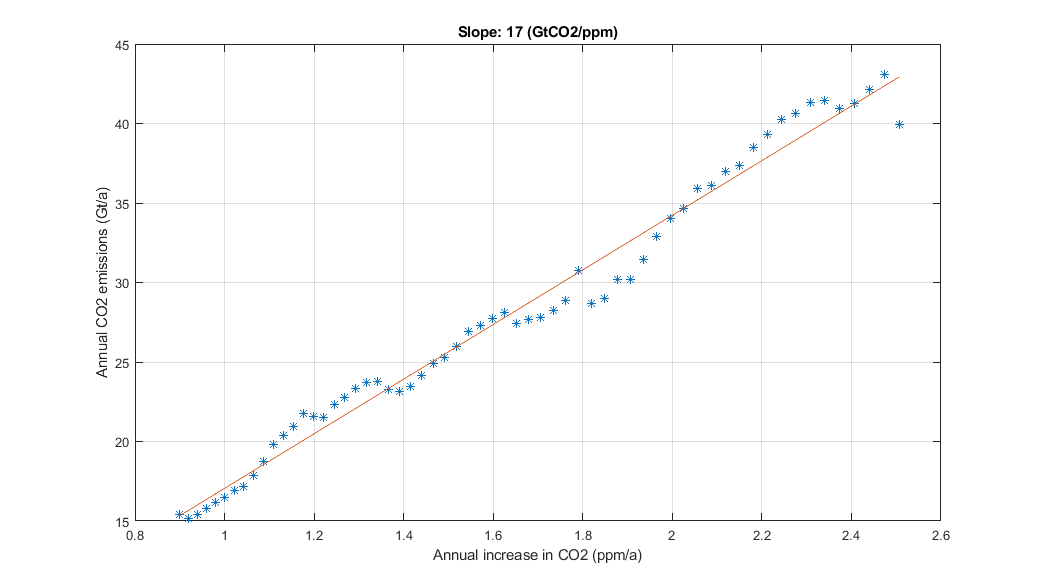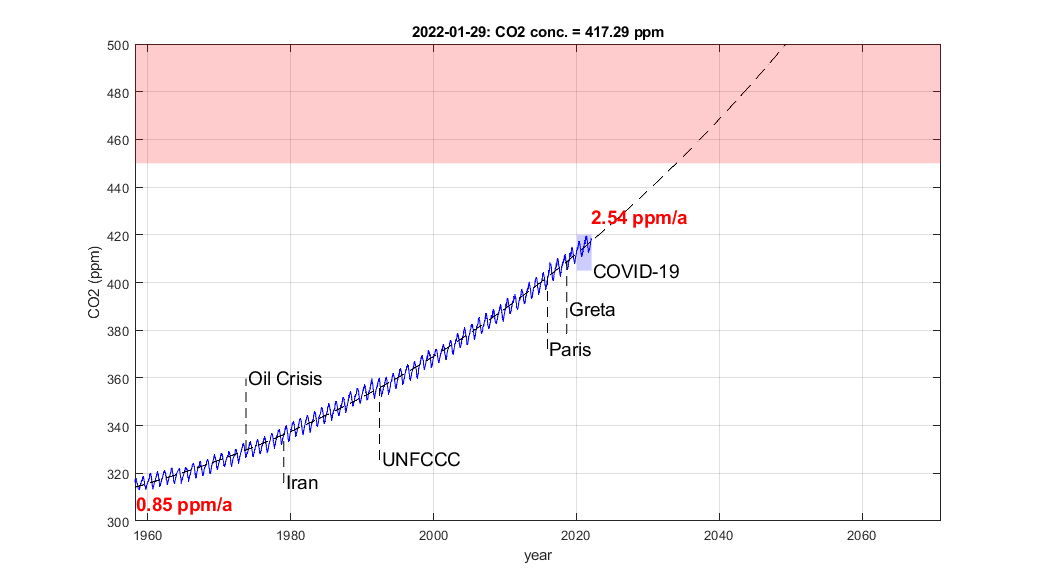· 4 min read
You only need three plots to understand everything about the climate crisis. The first is the Keeling-curve, which shows the carbon concentration in the atmosphere. The data are publicly available, and the figure below can be reproduced by anyone with an internet connection and a plotting program.

The solid blue line shows the measured data in units of parts per million (ppm). We have now reached a concentration of roughly 420 ppm, up from 280 ppm before the industrial revolution. Every third CO2 molecule in the atmosphere is now anthropogenic in origin. The oscillations correspond to the breathing of the planet: plants absorb CO2 in spring and summer and rerelease it during fall and winter. Since there is more landmass in the northern hemisphere, this effect is not symmetric. The amplitude of the oscillations is roughly 4 ppm, which provides an upper limit on the amount of CO2 that plants can absorb.
The carbon dioxide concentration is not only rising, but it is accelerating. The dashed black line represents a polynomial fit to the data. We see that the annual increase was 0.85 ppm at the end of the 50s and is approximately three times higher today (2.54 ppm/a). During the last 60 years, annual carbon emissions have been rising steadily, and neither the Oil Crisis in 1973, the Iranian revolution in 1979, the United Nations Framework Convention on Climate Change in 1992, the Paris Agreement in 2015, Greta Thunberg, nor COVID-19 has managed to change this trend.
We are accelerating towards the precipice, but any suggestion to remove the foot from the accelerator is still considered a radical political idea, and no mainstream politician dares to think about applying the brakes.
The shaded red area represents the danger zone above 450 ppm. This is too high for 1.5°C, but the exact value does not matter. As long as the slope of this curve continues to increase, we will pass any safe limit in the foreseeable future.
Where does the CO2 in the atmosphere come from? Using the polynomial fit from the diagram above and data for global emissions from the Global Carbon Project, we can create the following plot.

The message could not be clearer: the carbon concentration in the atmosphere increases because of anthropogenic carbon emissions. It requires 17 Gt of carbon dioxide to increase the concentration by one ppm. And 80-90% of the carbon comes from the use of fossil fuels.
Journalists, scientists, and politicians tend to make things more complicated than they have to be. Forget about cow farts, carbon capture, and budgets. We need to stop using fossil fuels as quickly as possible to save humanity. And we currently do not have a clue of how to do this. As shown in the last figure below, our current plan – growing the economy while slashing emissions – does not pass the bullshit test.

The same governments that signed the Paris Agreement in 2015 and the Glasgow Climate Pact in 2021 also attend G20 meetings, where they demand at least 2% economic growth. Apparently, we need a miracle to prevent catastrophic climate change. And hoping for a miracle is not a strategy.
Our fundamental problem is that our political and business leaders have no incentive to implement the policies needed to save humanity. As it is impossible to reduce emissions fast enough using innovation and technology, we need to stop manufacturing and consuming stuff. And capitalists do not like this idea.
Unfortunately, we are running out of time. I am just about to finish writing the official sustainability policy of our small university in Switzerland. It took us two years of negotiations and deliberations to agree on the goals for an organization with roughly 2000 employees. During this time, humanity used up more than 15% of the remaining CO2 budget for 1.5°C of warming. We cannot go on like this. Which part of “we have to reduce carbon emissions by at least 7% in 2022” do we fail to understand?
Global Climate Compensation would change the rules of international competition. It could be implemented immediately and would be entirely risk-free. What other choices do we have?
Energy Voices is a democratic space presenting the thoughts and opinions of leading Energy & Sustainability writers, their opinions do not necessarily represent those of illuminem.






